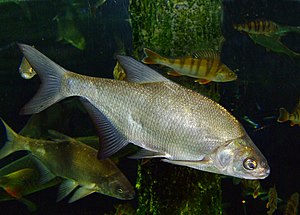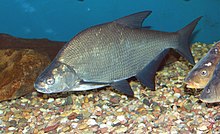Bream
| Bream | ||||||||||||
|---|---|---|---|---|---|---|---|---|---|---|---|---|

Bream ( Abramis brama ) |
||||||||||||
| Systematics | ||||||||||||
|
||||||||||||
| Scientific name of the genus | ||||||||||||
| Abramis | ||||||||||||
| Cuvier , 1817 | ||||||||||||
| Scientific name of the species | ||||||||||||
| Abramis brama | ||||||||||||
| ( Linnaeus , 1758) |

The bream ( Abramis brama ), mainly in Germany as bream (s) , regional as bream , Brachsme (s) , Bresen , Pliete or lead known is a fish art from the family of carp fish (Cyprinidae).
features
At the age of eight, bream can reach a length of approx. 30 to 50 cm. With a length of 60 cm, they weigh an average of 3 to 3.5 kg. Under ideal conditions, breams can weigh a maximum of 85 cm and over 8 kg, including the German record fish caught in 2000. Bream can reach an age of around 16 years.
Bream are very flattened on the sides and high back. If the bream is poorly fed , the so-called knife back , the formation of a very sharp edge on the back , occurs . The blunt mouth is slightly below, the eyes comparatively small.
The greenish, glossy, black to lead-gray or lead- blue color on the back is striking , to which the fish owe their name to lead . The sides have a metallic sheen, the belly is whitish with a pearlescent sheen . With older bream, a light bronze or gold-green tone comes through.
The scales are heavily covered with slime . The dorsal fin is 12-, the anal fin 26- to 31-rayed. Except for the pectoral fins, the fins are dark gray, the medium gray pectoral fins of the bream are long and reach up to the base of the pelvic fins. This differentiates them from the white bream , with which they are sometimes confused.
Simultaneous spawning times mix the eggs and seeds of lead and white bream (and other white fish ), resulting in so-called bastard fish , which can be differentiated based on the number and distribution of the fangs .
Occurrence
distribution
The bream are widespread in Europe north of the Alps and Pyrenees and in the Balkans . In the east they can be found as far as the Caspian Sea , the Black Sea and the Aral Sea and Balkhash Sea . The subspecies Abramis brama danubii lives in the Danube delta and the subspecies A. b. orientalis in the area of the Caspian Sea and the Aral Sea.
Types of water
Bream prefer bodies of water with a muddy bottom and carpets of underwater plants that provide cover and food. They live mainly in the so-called bream region of very slow flowing rivers (especially in lower reaches) and in lakes with a high nutrient content and muddy bottom. They live in small swarms close to the ground in the bank area .
Another large occurrence of bream is found in streams, canals for inland navigation, river ports, lakes, dams, park ponds and quarry ponds, where bream often find an ideal habitat.
Waters with large bream
Large bream are caught both in small gravel pits and in larger lakes. A small stock of fish, strong vegetation and sufficient predatory fish (mainly pike and perch ), which greatly reduce the stock of young fish, are ideal conditions. The high pressure of predatory fish means that only a few bream of a vintage are left and can therefore fully utilize the available food supply. Not only bream grow particularly quickly in this type of water, but also carp and other white fish such as fish. B. Roach. The relatively shallow and very nutritious Ismaning reservoir fulfills all these conditions and therefore also contains an excellent bream population of large and strong individual animals, which grow faster than average and reach high final weights.
- The best bream waters in Germany include large reservoirs such as B. the Möhnetalsperre . The largest bream in Germany are regularly caught in the Ismaninger reservoir near Munich , in the Wertach reservoir near Schwabmünchen , in the Forggensee and in the tributaries of Lake Constance .
- There were also record breams from the Weser (second best bream in Germany after the Ismaninger reservoir), the Rhine , Isar , Lech , Danube , Elbe , Alz , Segeberger See, Rottach , from Lake Constance , the Großer Plöner See and the Baltic Sea .
- Even smaller bodies of water like the Schwalm near Mönchengladbach can occasionally come up with 6 kg bream. In northern Germany , the Wilsterau west of Hamburg is an insider tip for particularly large bream. Record bream were also caught in the Lecker Au.
- In Austria , the Völkermarker Stausee and the Längsee in Carinthia are particularly good bream waters.
- Bream catches of up to 7.5 kg are reported in Denmark and Sweden .
Big breams migrate through the water in small schools, often at a greater distance from the bank, and out of caution they usually only go to the shallower bank areas at night. Larger bream are often found on the edges of headlands, on the sharp edge or in shallow reservoirs in the old river or stream bed.
nutrition
Their mouths can be pushed forward and helps the bream to find mosquito larvae , mud tube worms , mussels and snails in the soft mud. However, aquatic plants or plankton also serve as vegetable food. Bream can form large swarms, especially in larger rivers and lakes, which rummage through the ground like vacuum cleaners, use up food supplies in one place very quickly and then move on restlessly. Like other coarse fish, they form so-called bream roads, feeding routes through the water, which are visited at different times of the day.
The path of a swarm of bream is easily noticeable in shallow water through rising bubbles of swamp gas, which are released when rummaging through the ground.
Reproduction
The spawning season of the bream is from April to July and lasts about two weeks. In the event of a sudden change in the weather, spawning is interrupted and continued later. During the spawning season, a spawning rash is clearly noticeable on the body and head of the male.
During sometimes violent spawning games, the females lay their 150,000 to 300,000 sticky eggs 1.6 to 2 mm in diameter on aquatic plants; in areas without aquatic plants, they are also stuck to stones or roots. The larvae hatch after three to twelve days and also attach themselves to aquatic plants with special adhesive glands until their yolks are used up. The animals are sexually mature after three to four years.
Fouling
Especially in shallow and nutrient-rich lakes in Northern Germany, the enormous potential of the bream to reproduce leads to mass developments, which are then often associated with stagnating individual growth. If there are no predatory fish, bream also tend to dwarf in small bodies of water (e.g. rainwater retention basins). They then rarely become more than 10 centimeters long and have eyes that are unusually large compared to the body. This so-called debut occurs in all white fish (carp fish with the exception of carp), but also in perch , for example .
Due to the high density of individuals of the broiled bream, their population in such waters is extremely susceptible to disease. Within a very short time, the broached bream are sexually mature at an early stage and form the basis of the next generation of miniature fish. If you put these fish in a body of water with a high supply of nutrients, they will develop completely normally again.
The tendency to brood when overpopulated is the biggest problem when looking for large bream. It is difficult to find bodies of water that have large bream at all.
Hazard and protection
Bream, like all white fish, have a high rate of reproduction and populate the sluggish, slow-flowing lower reaches of large rivers and warm lakes as the main fish of the bream region in very large numbers. A threat to the bream is not foreseeable, as it can adapt well to anthropogenic water influences and their consequences. The International Union for Conservation of Nature ( IUCN) has the bream on the Red List of Endangered Species and assesses it as not endangered ( Least Concern ).
Whole vintages of bream are regularly lost, the fry probably not survive the first winter due to a lack of food (causes unknown). This can be seen as a natural population regulation of the species, it does not endanger its continued existence.
use
In comparison with historical data, a loss in economic sales can be recorded. Because of the bone-rich meat, the bream , which was previously sold as bread fish , is hardly eaten any more. Due to the immigration of Eastern Europeans, the bream is gaining in importance, around 3 euros are paid per kilogram of bream fillet from clean, unpolluted water.
Bream are usually the Stipp- or Feeder fishing (fishing with pose or a particular form of Grundangelns) caught. Baits are earthworms, maggots, maize , and also small boilies, especially for big bream from 2.5 kg upwards. Selectively catching Großbrachsen may be able to hook baits like nightcrawlers , corn grains or Caster (pupated maggots) act. In waters that are heavily frequented by people, such as quarry ponds, bream become as shy as carp and heavier specimens can then usually only be caught at dusk or at night.
In open waters, bream form a large part of the fish biomass. Smaller specimens of the bream are caught in greater numbers at all times of the day and night. In Europe, the Skanderborgseen and the Gudenau in Denmark are record waters for mass catches.
literature
- Sidineia Aparecida Amadio: The ecology of bream (Abramis brama) and rudd (Scardinius erythrophthalmus) in small eutrophic lakes. Colchester 1995.
- Tadeusz Backiel & Janusz Zawisza: Synopsis of biological data on the bream. in number 36 FAO fisheries synopsis. Rome 1968.
- Wilhelm Busch & Heinrich Kreymann: Bream and Bream . 1993.
- Erwin Fechner: Growth and nutrition of the bream (Abramis brama) in the Federsee. 1978.
- Fritz Geyer: Age and growth of the most important cyprinids in East Holstein lakes. in Vol. 34 Archives for Hydrobiology. Kiel 1938/39.
- Sven Heininger: Big bream live outside. Blinker 3 (2004): 74-77.
- Herbert Löffler: On the ecology of the bream (Abramis brama (L.)) in Lake Constance. Tübingen 1982.
- Rarely good bream. Blinker 3 (2004): 72/73.
- Honsig-Erlenburg, Wolfgang and Schulz Norbert, The Carinthian Fish, Klagenfurt, Natural Science Association (1989)
Web links
- Bream on Fishbase.org (English)
- www.biopix.dk - photos of bream
- www.pivi.de - Pisci Page: Bream (description and photo)
- www.fischfauna-online.de - Abramis brama - (Distribution data from Germany and Austria, further information)
Individual evidence
- ↑ Brassen just missed the German record - BLINKER . In: BLINKER . May 12, 2009 ( blinker.de [accessed December 30, 2017]).
- ↑ Abramis brama in the endangered Red List species the IUCN 2009 Posted by: J. Freyhof and M. Kottelat, 2008. Accessed on March 6 of 2010.
- ↑ Year Top Special Verlag: Blinker (04/2003).



